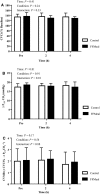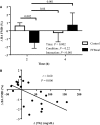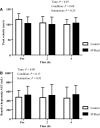Fast-food meal reduces peripheral artery endothelial function but not cerebral vascular hypercapnic reactivity in healthy young men
- PMID: 30221831
- PMCID: PMC6139709
- DOI: 10.14814/phy2.13867
Fast-food meal reduces peripheral artery endothelial function but not cerebral vascular hypercapnic reactivity in healthy young men
Abstract
Consumption of a representative fast-food meal (FFMeal) acutely impairs peripheral conduit artery vascular function; however, the effect on cerebral vascular function remains unknown. This study tested the hypothesis that a FFMeal would impair cerebral vascular function as indexed by an attenuated increase in cerebral vascular conductance (CVCI) in the middle cerebral artery (MCA) during a hypercapnic challenge. Ten healthy men (age: 24 ± 3 years, BMI: 24.3 ± 3.8 kg/m2 ) were studied under two conditions; a standardized FFMeal (990 kcals, 50% fat, 36% carbohydrate, 14% protein, and 2120 mg sodium) and a fasting control condition. Basal hemodynamics, cerebral vasomotor reactivity (CVMR), and brachial artery flow-mediated dilation (BA FMD) were completed after an overnight fast (Pre) and again 2 h and 4 h later both days. To assess CVMR, subjects rebreathed from a 5-L bag while MCA velocity (MCAVmean ) was measured using transcranial Doppler (TCD) ultrasound and converted into CVCI (MCAVmean /mean arterial pressure). Peripheral artery endothelial function was assessed via BA FMD following a standard 5-min occlusion protocol. As expected, BA FMD was reduced at 2 h (Pre: 6.6 ± 1.7% vs. 5.2 ± 1.8%, P = 0.01). However, despite significant impairment in BA FMD, neither peak CVCI%baseline nor CVMR was affected by the FFMeal (Control-Pre: 1.9 ± 1.1, 2 h: 2.1 ± 1.1, 4 h: 1.7 ± 1.1 ∆CVCI%·∆PET CO2-1 vs. FFMeal-Pre: 2.1 ± 1.1, 2 h: 2.2 ± 0.7, 4 h: 1.9 ± 0.9 ∆CVCI%·∆PET CO2-1 , time × condition P = 0.88). These results suggest that cerebral vascular reactivity to hypercapnia in healthy young men is not altered by an acute FFMeal.
Keywords: Atherosclerosis; Western diet; endothelial function; human; postprandial.
© 2018 The Authors. Physiological Reports published by Wiley Periodicals, Inc. on behalf of The Physiological Society and the American Physiological Society.
Figures



Similar articles
-
A high salt meal does not impair cerebrovascular reactivity in healthy young adults.Physiol Rep. 2020 Oct;8(19):e14585. doi: 10.14814/phy2.14585. Physiol Rep. 2020. PMID: 33038066 Free PMC article.
-
Cerebral vasomotor reactivity to carbon dioxide using the rebreathe technique: assessment of within-day and between-day repeatability.Am J Physiol Regul Integr Comp Physiol. 2024 Dec 1;327(6):R580-R589. doi: 10.1152/ajpregu.00030.2024. Epub 2024 Oct 14. Am J Physiol Regul Integr Comp Physiol. 2024. PMID: 39401485
-
Transcranial Doppler estimation of cerebral blood flow and cerebrovascular conductance during modified rebreathing.J Appl Physiol (1985). 2007 Mar;102(3):870-7. doi: 10.1152/japplphysiol.00906.2006. Epub 2006 Nov 16. J Appl Physiol (1985). 2007. PMID: 17110510
-
High-intensity interval exercise attenuates but does not eliminate endothelial dysfunction after a fast food meal.Am J Physiol Heart Circ Physiol. 2018 Feb 1;314(2):H188-H194. doi: 10.1152/ajpheart.00384.2017. Epub 2017 Nov 3. Am J Physiol Heart Circ Physiol. 2018. PMID: 29101171 Clinical Trial.
-
Cerebral Vasomotor Reactivity in Amnestic Mild Cognitive Impairment.J Alzheimers Dis. 2020;77(1):191-202. doi: 10.3233/JAD-200194. J Alzheimers Dis. 2020. PMID: 32716360
Cited by
-
The impact of a superfood chocolate beverage on indices of peripheral vascular function.Physiol Rep. 2025 Jul;13(13):e70448. doi: 10.14814/phy2.70448. Physiol Rep. 2025. PMID: 40611568 Free PMC article.
-
A high salt meal does not impair cerebrovascular reactivity in healthy young adults.Physiol Rep. 2020 Oct;8(19):e14585. doi: 10.14814/phy2.14585. Physiol Rep. 2020. PMID: 33038066 Free PMC article.
-
Impact of a 12-week personalized dietary intervention on vascular function and cardiovascular risk factors.Diabetes Obes Metab. 2025 May;27(5):2601-2612. doi: 10.1111/dom.16261. Epub 2025 Feb 27. Diabetes Obes Metab. 2025. PMID: 40013435 Free PMC article. Clinical Trial.
-
Impact of COVID-19 outbreak on patients with ST-segment elevation myocardial ınfarction (STEMI) in Turkey: results from TURSER study (TURKISH St-segment elevation myocardial ınfarction registry).J Thromb Thrombolysis. 2022 Feb;53(2):321-334. doi: 10.1007/s11239-021-02487-3. Epub 2021 May 29. J Thromb Thrombolysis. 2022. PMID: 34050883 Free PMC article.
-
Normal variations in brain oxygen extraction fraction are partly attributed to differences in end-tidal CO2.J Cereb Blood Flow Metab. 2020 Jul;40(7):1492-1500. doi: 10.1177/0271678X19867154. Epub 2019 Aug 5. J Cereb Blood Flow Metab. 2020. PMID: 31382788 Free PMC article.
References
-
- Akbari, C. M. , Saouaf R., Barnhill D. F., Newman P. A., LoGerfo F. W., and Veves A.. 1998. Endothelium‐dependent vasodilatation is impaired in both microcirculation and macrocirculation during acute hyperglycemia. J. Vasc. Surg. 28:687–694. - PubMed
-
- Bae, J.‐H. , Bassenge E., Kim K.‐B., Kim Y.‐N., Kim K.‐S., Lee H.‐J., et al. 2001. Postprandial hypertriglyceridemia impairs endothelial function by enhanced oxidant stress. Atherosclerosis 155:517–523. - PubMed
-
- Bayerle‐Eder, M. , Wolzt M., Polska E., Langenberger H., Pleiner J., Teherani D., et al. 2000. Hypercapnia‐induced cerebral and ocular vasodilation is not altered by glibenclamide in humans. Am. J. Physiol. Regul. Integr. Comp. Physiol. 278:R1667–R1673. - PubMed
MeSH terms
LinkOut - more resources
Full Text Sources
Other Literature Sources
Research Materials

